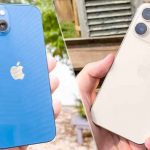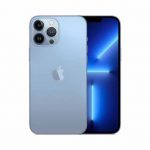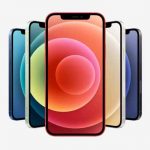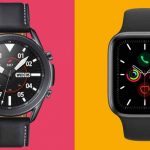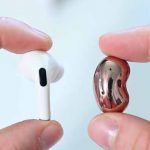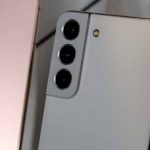The iPhone 13 is out now, while the Samsung Galaxy S21 has been in the game for most of 2021. So how do these two mainstream flagship phones, launched a whole eight months apart, compare?
iPhone 13 vs. Samsung Galaxy S21: price and availability
The iPhone 13 hit shops on September 24, 2021. Prices start from $799 / £799 / AU$1,349 for the entry 128GB model, moving up to $899 / £879 / AU$1,519 for 256GB and $1099 / £1079 / AU$1,869 for 512GB.
The Samsung Galaxy S21 arrived in shops much earlier on January 29, 2021, with prices starting from $799 / £769 / AU$1,249 for the 128GB model. The 256GB model arrived at $849.99 / £819 / AU$1,349.
While Samsung still officially lists these prices on its website, you can find the Galaxy S21 cheaper elsewhere. It’s only going to drop in price as we get nearer to the launch of the Samsung Galaxy S22 in 2022, too.
iPhone 13 vs. Samsung Galaxy S21: design
They might be fierce rivals operating in the same market, but the iPhone 13 and Samsung Galaxy S21 don’t look much alike. The iPhone 13 takes its design cues from last year’s iPhone 12, with flat surfaces, sharp corners, and a prominent display notch – though the latter is 20% smaller than before.
In the opposite corner, the Samsung Galaxy S21 is all about the curves, with rounded edges and a distinctive ‘Contour Cut’ camera module. It does have a flat display like the iPhone 13, but it has a much more subtle punch-hole camera.
These are two fairly compact phones, and they’re not all that different when it comes to size. At 146.7 x 71.5 x 7.65mm, the iPhone 13 is a tad shorter and slimmer than the 151.7 x 71.2 x 7.9mm Galaxy S21. Samsung’s phone is ever so slightly lighter at 169g, however, with the iPhone 13 tipping the scales at 174g.
Both phones employ aluminum bodies, but whereas the iPhone 13 goes with a classy glass rear, the Galaxy S21 cheaps out with a plastic finish Samsung calls ‘Glasstic’. We’re not huge fans, in truth.
When it comes to colors, the iPhone 13 gives you Pink, Blue, Midnight, Starlight, and Product Red, while the Galaxy S21 gives you a choice of Phantom Gray, Phantom White, Phantom Pink, and Phantom Violet.
Ultimately, that plastic rear costs the Galaxy S21 the win in the design department. The iPhone 13 gets much closer to the iPhone 13 Pro in look and feel than the Galaxy S21 does to the Galaxy S21 Ultra.
iPhone 13 vs. Samsung Galaxy S21: display
Samsung hits straight back with a slightly more impressive display. These are similarly sized OLEDs at 6.2-inches for the Samsung and 6.1-inches for the Apple, and both get plenty bright.
But while the iPhone 13 has the slightly sharper 1170 x 2532 resolution (versus the 1080 x 2400 Galaxy S21), the Samsung wins out in one vital aspect.
Apple restricted its 120Hz refresh rate improvement to the Pro model this year, leaving the iPhone 13 on sluggish old 60Hz. The Galaxy S21, by contrast, runs at a full 120Hz.
As a result, Samsung’s display simply feels slicker, more responsive, and just plain better than Apple’s. It also doesn’t have that distracting display notch to contend with, which makes landscape video and gaming content look that little bit better on the Samsung.
Specs and camera
The iPhone 13 is powered by Apple’s latest A15 Bionic chipset, with a six core CPU, a four core GPU and a 16 core Neural Engine. It comes with 4GB of RAM.
The 5nm chip powers Apple’s new Cinematic mode and features like Live Text that can pull addresses and phone numbers from your photo library. It’s also capable of running countless games with Apple Arcade.
The Galaxy S21 features the Qualcomm Snapdragon 888 chipset in the US or the Exynos 2100 in Europe, including here in the UK. It comes with 8GB of RAM – twice that in the iPhone 13.
We found the Exynos 2100 to be a major step-up from previous Exynos chipsets. Like the A15, the 2100 is based on a 5nm process, allowing it to offer better battery life compared with the S20. The GPU has also be updated, offering no issues with gaming performance.
One major difference is operating systems – the iPhone 13 runs on Apple’s own iOS 15 software, while the S21 features Google’s Android 11, with an upgrade to Android 12 on its way.
The iPhone 13 features a dual rear camera, made up of a 12-megapixel wide angle lens with an f/1.6 aperture and a 12-megapixel ultra-wide angle lens with an f/2.4 aperture. The camera is capable of reaching 5x digital zoom and there’s a 12-megapixel TrueDepth (f/2.2) camera on the front of the phone for selfies.
The iPhone can record 4K video at up to 60fps and features Dolby Vision support as well as Apple’s aforementioned Cinematic mode, which offers a shallow depth of field when recording in 1080p at 30fps.
The S21 features a triple rear camera, meaning it has one more lens than the iPhone 13. Like the iPhone, it has two 12-megapixel sensors – one wide angle with an f/1.8 aperture and the other an ultra-wide angle lens with an f/2.2 aperture. There’s also a third 64-megapixel telephoto (f/2.0) lens, offering 3x hybrid optic zoom and up to 30x super resolution zoom.
The S21 can capture 8K video at 24fps, 4K at 60fps and includes support for HDR10+. There’s also a 10-megapixel selfie camera on the front with an aperture of f/2.2.
Battery life
As far as battery life is concerned, the iPhone 13 showed large improvements over the iPhone 12 thanks to its larger cells and more efficient chipset.
We found that streaming Netflix at 75% brightness in HDR ate through 7% of the iPhone’s battery. For comparison, the Galaxy S21 used up 8% of its own battery streaming Netflix in HDR at just 50%.
That said, both phones should be able to get you through a day of real-world use, though neither comes with a charging plug in the box anymore. Luckily, the iPhone does come with a Lightning cable and you shouldn’t have too much trouble sourcing a USB-C cable from your laptop or a tablet to charge up the S21 – though charging speeds may vary.
Both phones support wireless charging, with the iPhone also supporting its own MagSafe technology as well as Qi. The S21, meanwhile, takes advantage of reverse charging for when you want to lend your battery to a smartwatch or pair of earbuds
Samsung Galaxy S21 vs. iPhone 13: Software and special features
If you’re the type to look for silver linings, take comfort in the fact that the Galaxy S21 FE’s delayed launch — the phone was expected last year — means that it ships with Android 12. That means you don’t have to wait for a software update to enjoy the latest version of Android. Given Samsung’s software update policy of three years of Android updates, your Galaxy S21 FE should be a viable phone for some time.
But that still falls short of Apple’s level of software support, where phones can go four to five years running the latest version of Apple’s iPhone software. In the case of the iPhone 13, that’s iOS 15, which brings a number of nice features to the mix including the ability to watch movies and listen to music with other people in FaceTime.
Comparing the software experience on the Galaxy S21 FE vs. the iPhone 13 likely comes down to your preference of Android vs. iOS, so Apple’s extended software support is really the deciding factor here.
Audio Quality
iPhone has much more impressive loudspeakers
While both the iPhone and the Galaxy are equipped with a dual speaker system consisting of a main, bottom-firing speaker and a secondary one, embedded in the earpiece, there is a difference in audio quality.
Playing back music on the Galaxy, you have decent audio quality, but nothing impressive and there is no depth to the sound. The iPhone, on the other hand, sounds impressively boomy and rich, with a bass you don’t expect to hear on a phone. It really is a next level kind of experience on the iPhone and if you care about loudspeaker quality, well… the iPhone gets an easy win.
Which one is right for you?
These phones are plenty different from each other, and they each share their own strengths and weaknesses. The Samsung Galaxy S21 offers a much nicer screen and fancier specs, while the iPhone has better performance and a more reliable camera system.
At the end of the day, it’s hard to pinpoint which one is truly better than the other. We’re inclined to say the iPhone 13 takes the cake, thanks to its performance and cameras, but those who might value faster charging and a nicer screen will enjoy the Galaxy S21.
It comes down to your own personal preferences if you’re debating whether to buy the iPhone or the S21. Both are terrific devices, and you’ll be pleased with either of them. Just keep in mind what you value in a smartphone when making your decision.
Apple’s iPhone 13 has a modern build with an immersive display, with the best performance and one of the best cameras of all the phones we’ve ever tested. Samsung’s Galaxy S21 is an excellent Android with a smooth and vibrant display, a triple camera system and performance that comes close to our top pick.
But performance is one area where the iPhone 13 absolutely dominates. Apple claims its 5nm A15 Bionic chipset packs a six-core CPU that’s 50% faster than its Android competition, which presumably includes the Galaxy S21’s Exynos 2100 (or the slightly better Snapdragon 888 in the US model).
In general, the pro models of the S21 line have better zoom chops than the higher-end iPhone 12s. For instance, the S21 Pro has a dedicated 64-megapixel telephoto camera that can zoom to a 30x magnification, while the iPhone 12 Pro, which has a fantastic telephoto camera, maxes out at 12x.
Apple’s 256GB of storage is rather generous and should be the best choice for most people. … It’s also the lowest storage option for the iPhone 13 Pro and iPhone 13 Pro Max that will support 4K ProRes video recording at 30 frames per second.
Also read:
- Earphones vs. Headphones. The Best Wireless Earbuds for 2022
- Is Google Assistant better than Siri and Alexa? What is the Best AI Virtual Assistant?
- Which Powerbeats are the best? Are AirPods better than Beats?
- The Freestyle Samsung Projector Review. Which is best projector for home use?
- What is the difference between iPhone 13 and 13 pro + Video Review
